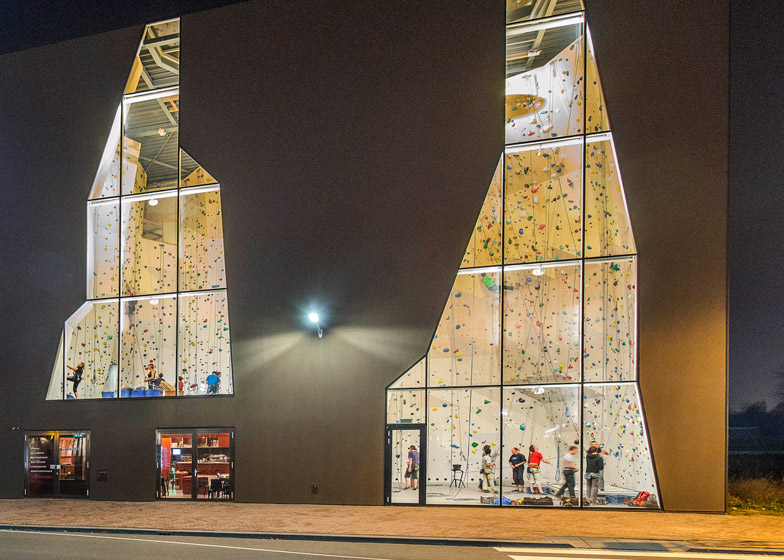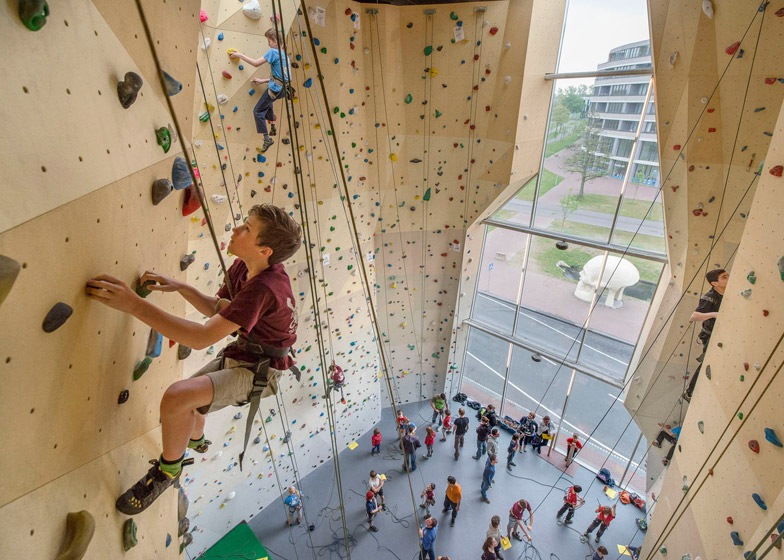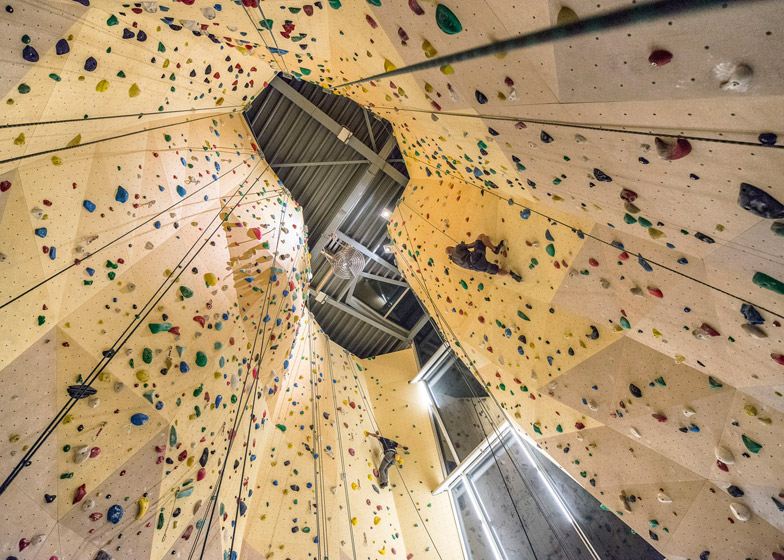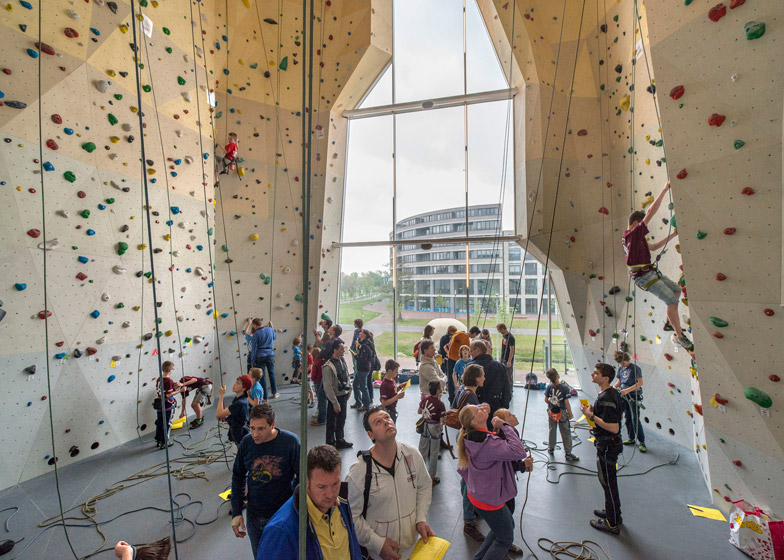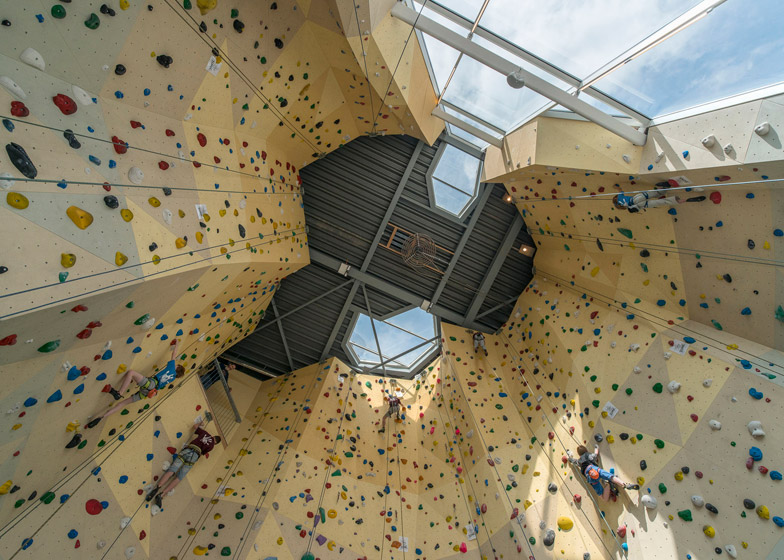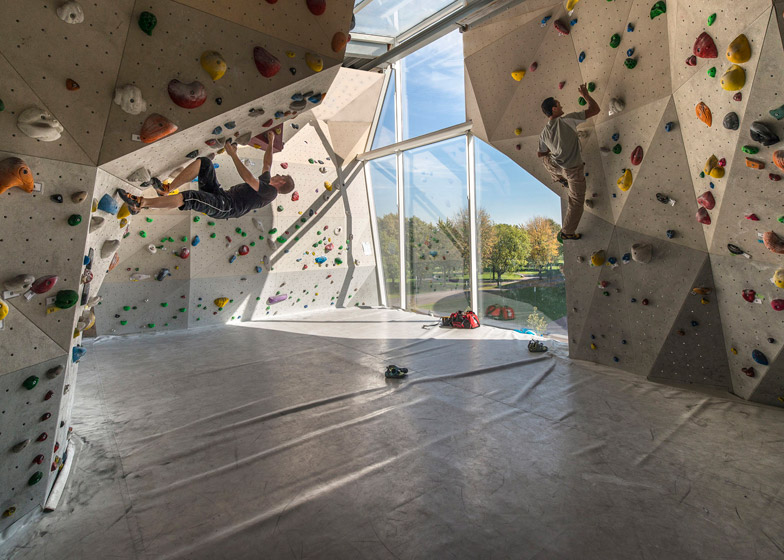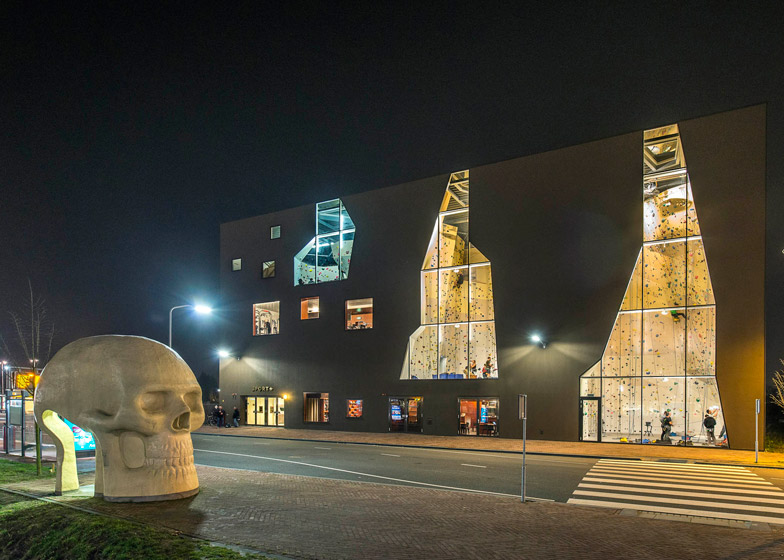Amsterdam office NL Architects added angular windows to the facade of this sports centre in Dordrecht, the Netherlands, to frame views of three climbing walls inside (+ slideshow).
The Spordtgebouw facility was designed by NL Architects as part of the masterplan for the city's Leerpark district by international firm West 8, which will eventually involve constructing more buildings on either side of the complex.
As the end section is the only facade that will ultimately be visible, the architects introduced cave-like apertures as a showpiece for the centre.
"Adding this 'cave' increases the programmatic capacity of the building and its expression. By applying a function to the elevation the obligatory sports hall look could be avoided," explained NL Architects, whose previous designs include a cycle-hire shop with a velodrome on the roof and a gymnasium with swollen walls.
Facilities for three separate schools are contained in the complex, so the architects arranged the eight different sports halls over two levels to reduce the required footprint.
Creating a shared building for different schools allows the halls to be dedicated to specific activities, which are used by pupils during the day and by the local community in the evenings and at weekends.
Four sports halls are located on the ground floor, with two on either side of a central utility area used for storing equipment.
A corridor leads from the entrance to changing rooms arranged along one of the long elevations, which are connected to the adjacent sports halls.
The upper storey houses two larger halls with higher ceilings, which can be divided if required. Changing facilities are situated in a lower adjoining section.
The gap between the halls and the building's facade accommodates three separate climbing walls that begin at different levels.
Irregular windows employ the same angular aesthetic as the wooden climbing surfaces, providing glimpses of the activities taking place inside, while filling the interior with natural light.
Glazed sections in the corrugated metal ceiling provide views of the sky as climbers ascend.
A cafeteria is accommodated on the ground floor between the entrance and the largest climbing wall, with the space above the entrance housing a gymnasium and the smallest climbing area on the upper storey dedicated to bouldering.
Photography is by Ralph Kämena.
Here's some more information from NL Architects:
Spordtgebouw, Dordrecht
Spordtgebouw is a combined sports facility for three separate schools in the so-called 'Leerpark'. Traditionally, individual schools have their individual gymnasiums. But by combining the sports halls into one compound the quality of sports education can be improved. A higher degree of collectivity of course enhances complexity but sharing also creates added value. It will for instance be possible to differentiate the halls and apply specific functions like a Dojo. During the day the building is dedicated to the schools, but in the evening and weekends it is open to everybody. As such public money will be used publicly.
In order to reduce the impact on the surroundings the halls are stacked, the footprint is minimised. In total there are four smaller halls of 22 times 13 times 5.5 meter and two bigger halls of 22 x 28 meter. With 7 meters headroom the main halls are slightly higher. The main halls can be divided in two. The building can accommodate eight different classes at the same time.
Since Sports halls are BIG boxes they tend to be clad in cheap materials, often corrugated steel. The Spordtgebouw however will be embedded in the new urban fabric of the Leerpark; the sides will be encapsulated by new buildings. The design of the side facades becomes irrelevant. One facade remains crucial though: it is facing the Boulevard.
In the leftover space between the most compact configuration of the halls and the site boundary a thin slab could be introduced containing an indoor climbing hall. Adding this 'cave' increases the programmatic capacity of the building and its expression. Climbing is considered a helpful tool in the education of basic values of trust, responsibility and team spirit. By applying a function to the elevation the obligatory 'sports hall look' could be avoided. The expressive character is created by 'slicing' a standard climbing hall; the interior is exposed and becomes Logo!
Client: Properstok / Heijmans Vastgoed / City of Dordrecht
Users: Insula College, Stedelijk Dalton Lyceum and Wartburg College
Urban Plan: West 8
NL Architects: Pieter Bannenberg, Walter van Dijk, Kamiel Klaasse
Preliminary Design Stage Re-Development: Wim Sjerps and Arne van Wees
Definitive Design Stage: Wim Sjerps and Arne van Wees
'Definitive' Definitive Design Stage and Execution: Bobby de Graaf, Stephan Schülecke, Arne van Wees with Yannick van Haelen and Detail BV
Coordination: BBN Adviseurs
Structural Engineers: Ingenieursbureau Zonneveld BV
Building Physics / Acoustics: Peutz
Installations: Burgers Ergon
Climbing wall: ONL
Contractor: Heijmans Bouw BV

